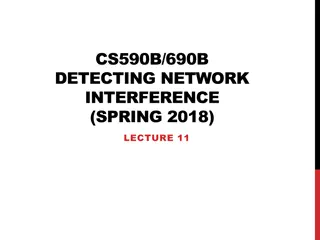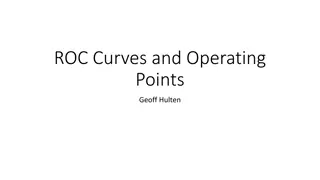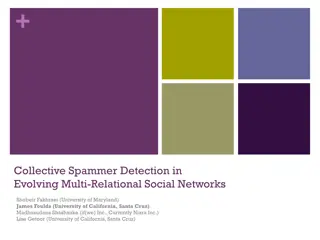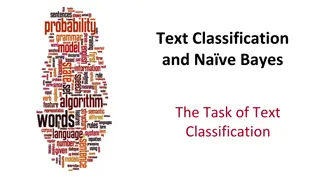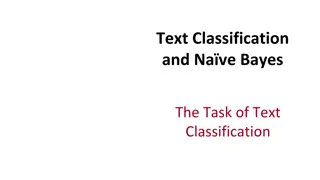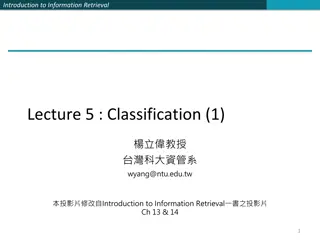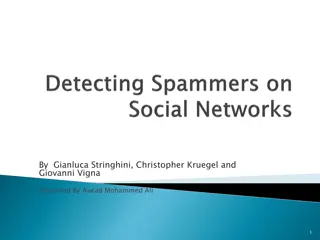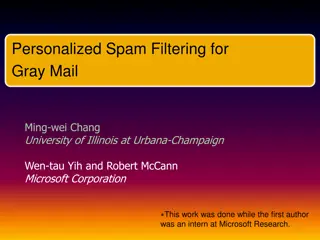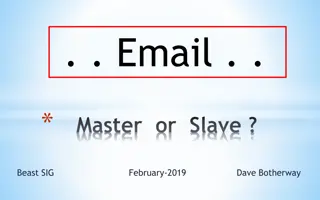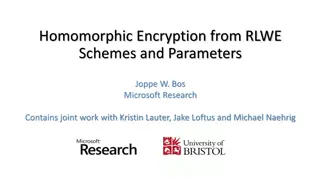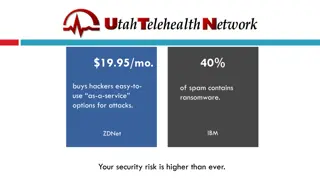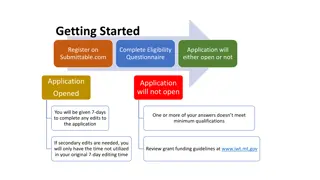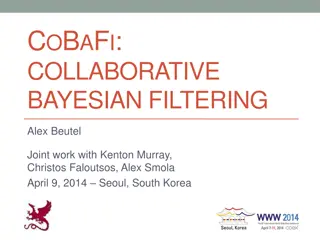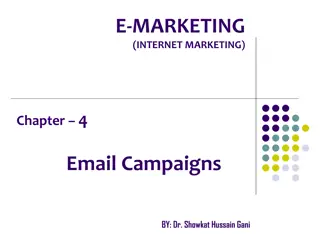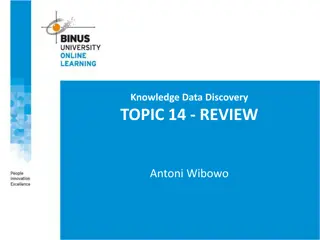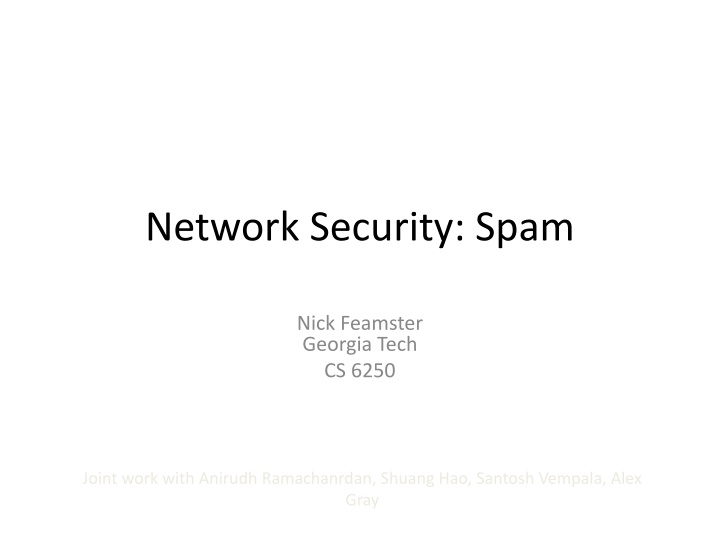
Combatting Spam in Network Security: Strategies and Challenges
Explore the battle against spam in network security, tackling issues like increasing internet penetration, unwanted traffic reduction, and distinguishing spam from legitimate mail through content-based filtering and sender IP addresses.
Uploaded on | 1 Views
Download Presentation

Please find below an Image/Link to download the presentation.
The content on the website is provided AS IS for your information and personal use only. It may not be sold, licensed, or shared on other websites without obtaining consent from the author. If you encounter any issues during the download, it is possible that the publisher has removed the file from their server.
You are allowed to download the files provided on this website for personal or commercial use, subject to the condition that they are used lawfully. All files are the property of their respective owners.
The content on the website is provided AS IS for your information and personal use only. It may not be sold, licensed, or shared on other websites without obtaining consent from the author.
E N D
Presentation Transcript
Network Security: Spam Nick Feamster Georgia Tech CS 6250 Joint work with Anirudh Ramachanrdan, Shuang Hao, Santosh Vempala, Alex Gray
Internet Penetration is Increasing More people Today: 1.9B users 2020: 5B users More global Africa, India: ~7% penetration More traffic 44 exabytes by 2012 Source: internet world stats As the Internet continues to reach more people, the stakes for controlling access to information will increase. 2
The Battle for Control Reducing unwanted traffic: As much as 95% of email traffic is spam Spam moving to new domains such as Twitter About 50k new phishing attacks every month Facilitating free and open communication: Nearly 60 countries censor Internet content
Spam: More than Just a Nuisance 95% of all email traffic Image and PDF Spam (PDF spam ~12%) As of August 2007, one in every 87 emails was a phishing attack Targeted attacks on rise ~50,000 unique phishing attacks per month Source: APWG 4
Approach: Filter Prevent unwanted traffic from reaching a user s inbox by distinguishing spam from ham Question: What features best differentiate spam from legitimate mail? Content-based filtering: What is in the mail? IP address of sender: Who is the sender? Behavioral features: How the mail is sent? 5
Approach #1: Content Filters PDFs Excel sheets Images ...even mp3s!
Problems with Content Filtering Customized emails are easy to generate: Content-based filters need fuzzy hashes over content, etc. Low cost to evasion: Spammers can easily alter features of an email s content can be easily adjusted and changed High cost to filter maintainers: Filters must be continually updated as content-changing techniques become more sophisticated 7
Approach #2: IP Addresses Received: from mail-ew0-f217.google.com (mail-ew0-f217.google.com [209.85.219.217]) by mail.gtnoise.net (Postfix) with ESMTP id 2A6EBC94A1 for <feamster@gtnoise.net>; Fri, 21 Oct 2011 10:08:24 -0400 (EDT) Problem: IP addresses are ephemeral Every day, 10% of senders are from previously unseen IP addresses Possible causes Dynamic addressing New infections 8
Main Idea: Network-Based Filtering Filter email based on how it is sent, in addition to simply what is sent. Network-level properties: lightweight, less malleable Network/geographic location of sender and receiver Set of target recipients Hosting or upstream ISP (AS number) Membership in a botnet (spammer, hosting infrastructure) 9
Challenges Understanding network-level behavior What network-level behaviors do spammers have? How well do existing techniques (e.g., DNS-based blacklists) work? Building classifiers using network-level features Key challenge: Which features to use? Two Algorithms: SNARE and SpamTracker Anirudh Ramachandran and Nick Feamster, Understanding the Network-Level Behavior of Spammers , ACM SIGCOMM, 2006 Anirudh Ramachandran, Nick Feamster, and Santosh Vempala, Filtering Spam with Behavioral Blacklisting , ACM CCS, 2007 Shuang Hao, Nick Feamster, Alex Gray and Sven Krasser, SNARE: Spatio-temporal Network-level Automatic Reputation Engine , USENIX Security, August 2009 10
Surprising: BGP Spectrum Agility Hijack IP address space using BGP Send spam Withdraw IP address A small club of persistent players appears to be using this technique. Common short-lived prefixes and ASes 61.0.0.0/8 4678 66.0.0.0/8 21562 82.0.0.0/8 8717 ~ 10 minutes Somewhere between 1-10% of all spam (some clearly intentional, others flapping ) 11
Other Findings Top senders: Korea, China, Japan Still about 40% of spam coming from U.S. More than half of sender IP addresses appear less than twice ~90% of spam sent to traps from Windows 12
Challenges Understanding network-level behavior What network-level behaviors do spammers have? How well do existing techniques (e.g., DNS-based blacklists) work? Building classifiers using network-level features Key challenge: Which features to use? Two Algorithms: SNARE and SpamTracker Anirudh Ramachandran and Nick Feamster, Understanding the Network-Level Behavior of Spammers , ACM SIGCOMM, 2006 Anirudh Ramachandran, Nick Feamster, and Santosh Vempala, Filtering Spam with Behavioral Blacklisting , ACM CCS, 2007 Shuang Hao, Nick Feamster, Alex Gray and Sven Krasser, SNARE: Spatio-temporal Network-level Automatic Reputation Engine , USENIX Security, August 2009 13
Finding the Right Features Goal: Sender reputation from a single packet? Low overhead Fast classification In-network Perhaps more evasion-resistant Key challenge What features satisfy these properties and can distinguish spammers from legitimate senders? 14
Set of Network-Level Features Single-Packet Geodesic distance Distance to k nearest senders Time of day AS of sender s IP Status of email service ports Single-Message Number of recipients Length of message Aggregate (Multiple Message/Recipient) 15
Sender-Receiver Geodesic Distance 90% of legitimate messages travel 2,200 miles or less 16
Density of Senders in IP Space For spammers, k nearest senders are much closer in IP space 17
Local Time of Day at Sender Spammers peak at different local times of day 18
Combining Features: RuleFit Put features into the RuleFit classifier 10-fold cross validation on one day of query logs from a large spam filtering appliance provider Comparable performance to SpamHaus Incorporating into the system can further reduce FPs Using only network-level features Completely automated 19
SNARE: Putting it Together Email arrival Whitelisting Greylisting Retraining 20


